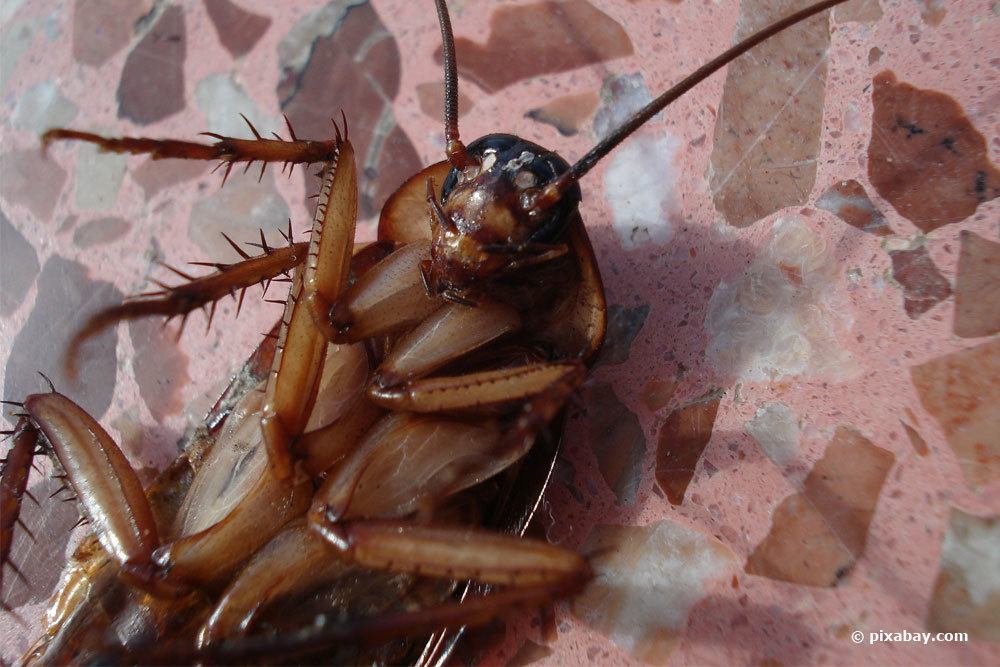Some just find them disgusting. Others are directly afraid of cockroaches, because the small creepy-crawlies might bite or sting. Therefore, they are not welcome guests within their own four walls. Everything is done to get rid of them quickly. But do they really pose a health risk to humans?
Cockroaches also known as common cockroaches (Blatta orientalis) directly seek the proximity of humans. Exactly here are extremely ideal conditions for a carefree life. In addition to temperatures usually above the 20 degree mark, they also find kitchen waste and other food scraps and, above all, moisture. Simply a paradise for cockroaches. Mostly cockroaches are associated with dirt, filth or uncleanliness, but they also feel comfortable in a clean environment.
Contents
Good breathers
Cockroaches directly seek moisture and, associated with it, warmth. They are most likely to find this in basements, bathrooms and likewise kitchens. They often get to these places through faulty plumbing and sewage systems.
Cockroaches are able to hold their breath for at least 40 minutes and survive 30 minutes under water. They take advantage of this ability to swim through the sewers to their new quarters. This allows them to travel longer distances underwater and they don’t even have to breathe to do it. Very often, the insects find their way into apartments through the toilet. So swimming is not a problem for the animals.
Note: The cockroach can survive at least a week without a head. They do not breathe like normal creatures, but through small holes (stigmata) in the body. Oxygen is taken in through these. Likewise, through these openings water is transported to the outside, for this purpose simply close the breathing tubes.

Sometimes it is also assumed that the 13 to 16 mm large light to dark brown colored cockroaches can fly, because there is a pair of small wings on their foremost section of the thorax (prothorax). Usually, however, these are fully developed only in females. In males, they tend to be atrophied.
Thus, female animals can save their offspring in case of imminent danger by simply flying away. The animals carry the eggs under their carapace until they hatch. Males, on the other hand, look somewhat clumsy in their attempts to fly. Due to their body proportions, light males are capable of a short gliding flight. However, it looks very ponderous and swaying through the air.
However, they have made a virtue of this and use the wings helpfully to
- slow down falls from heights
- to cover shorter distances
- to make higher jumps
Especially during their jumps they start to flap their wings. It usually then looks as if the animals are flying.
Note: In warmer areas it can be observed that the warmth favors the development of the wings. There the cockroaches are also more often flying.
It should be mentioned, however, that not all cockroach species are “flightless”, for example, the American and Australian cockroach may well take to the skies on warm days. In our latitudes, the amber cockroach is one of the flight-capable specimens. However, it lives exclusively in the forest. The European cockroach covers its distances rather running and jumping.
Fast runners
However, it must be conceded that these small animals are extraordinarily good and, above all, very fast for their conditions on foot. They can cover about 1.5 meters within one second. They make use of this fact especially when escaping from enemies.
In comparison, a human being would have to walk at least 250 kilometers in one hour at the speed of these little speedsters. This makes the cockroach one of the fastest insects in this country.
Are bites harmful to health?
Cockroaches are usually nocturnal. They are shy of light, so they hide in their shelters during the day and only emerge at nightfall. If cockroaches are spotted during the day, then the infestation of cockroaches is already extremely invasive. As a rule, cockroaches are considered storage pests, but at the same time they are omnivores. Mainly they feed on organic substances like
- fruits, vegetables
- meat of dead animals
- feces
- human dander and hair
- paper, glue or
- leather
In case of need, when food is scarce, also from their own conspecifics. Considering the situation that they also bite through and eat leather, they have appropriate mouthparts, which can also penetrate human skin. So, in principle, they could bite or sting humans. But it is not known that a cockroach would actively bite a human. As a rule, it would probably rather take flight to ultimately avoid injury or escape death.
Should a cockroach bite nevertheless once, then surely only during the night and on the search for food and water. Such a wound is recognizable by
- swelling around the bite
- delayed onset, severe pain
Of course, the wound must be thoroughly disinfected to prevent infection. If it does, a doctor should definitely be consulted.
Disease risk from bite
Even though cockroaches rarely bite, the presence of these animals in the vicinity of humans and also pets poses a particular health risk. They can transmit diseases, the course of which is associated with more or less serious health damage for humans and animals, such as
- Hepatitis A
- Anthrax
- Salmonella
- Tuberculosis
- colitis and
- more rarely leprosy
Transmission usually occurs through
- the outer skin of the animals
- contaminated food
- excrements of the animals
- skinning remains
Germs can adhere to the outer skin of cockroaches for up to 72 hours. Even if there is no direct contact with the animals, the risk of infection is high. Children, senior citizens and people who are already ill are particularly at risk.
Note: Cockroaches can also transmit diseases in agriculture. They are particularly fond of nesting in warm, damp animal stalls and can transmit foot-and-mouth disease.

